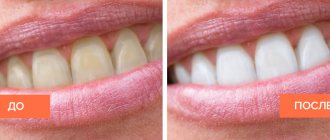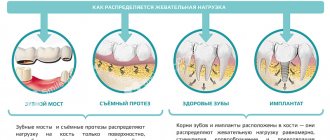01.12.2019
Every preschooler knows exactly how many times a day he needs to brush his teeth - twice: in the evening and in the morning. But not everyone knows about the existence of exceptions to this rule and about the correct technique for carrying out the hygiene procedure. This will be discussed in the article.
Why do you need to brush your teeth?
Oral hygiene is not only a matter of aesthetics. It is due to medical reasons. A plaque constantly forms on the enamel, consisting of: • food particles; • saliva; • waste products of microorganisms inhabiting the oral cavity.
The process of plaque deposition does not depend on whether a person ate in the interval between brushings. If it is not removed, over time it turns to stone. Contamination not only creates a cosmetic defect. Deposits contribute to the violation of the integrity of the enamel. Pathogenic bacteria penetrate into the resulting cracks and actively multiply under conditions of poor hygiene. This is how caries begins with all the known consequences. These microorganisms also attack the gums. In people who neglect to brush their teeth, gingivitis becomes chronic. If the inflammation is not treated, complications in the form of periodontitis and periodontal disease are possible. As a result, the root no longer holds in the socket and the tooth falls out.
WHY ARE COMPLEX TEETH DONE IN PARTNER-MED?
We know how to work!
We have orthopedic dentists with 8-30 years of experience!
We love to work!
We will give you a free consultation and tell you exactly how best to make your teeth better!
We are responsible for the result!
We work conscientiously and will make your teeth LIKE YOURSELF!
How many minutes should you brush your teeth?
On average, each teeth brushing should last from 2 to 5 minutes. Teeth brushing, photo
How to brush your teeth correctly?
It is a mistaken idea that everyone can do this. There are a number of rules, many of which are either unknown or ignored. However, only compliance with them guarantees effective cleaning of the enamel: • Carrying out hygiene procedures not only at home, but also at the dentist. • Rational selection of brushes and paste. • Using the optimal teeth brushing method. • Using dental floss, brushes and mouthwash. • Taking into account the condition of the gums, the presence of braces and dentures. • Compliance with the rules for storing, cleaning and replacing brushes.
Tablets for determining plaque will help you understand whether you have achieved your goal. They demonstrate whether unwanted deposits are present on the enamel. They also suggest which areas are not being worked through carefully enough.
The right time
People who carefully monitor their health try to remove bacterial plaque after each meal. Such manipulations reduce the risk of enamel destruction: carious bacteria are able to multiply and activate only in a suitable environment. On clean teeth, it will be more difficult for pathogenic flora to develop and produce acids that destroy the top layer of teeth.
During hygiene procedures, it is necessary to take into account some rules regarding the timing of cleaning. For example, morning oral care is best done after breakfast, and not vice versa. The need for morning cleansing after meals is due to several factors:
- distortion of the taste properties of food after using toothpastes;
- the possibility of staining the enamel after taking coloring drinks and foods (especially after using bleaching compounds).
Attention! Avoid brushing your teeth immediately after eating acidic foods. Acid tends to soften plaque and tooth tissue, so hygiene measures can lead to thinning of the enamel and increased sensitivity to cold and hot foods.
After breakfast, you should wait 30 minutes before brushing your teeth. This rule must be followed by both children and adults. It minimizes the appearance of microcracks in the enamel.
Choosing a toothbrush
To completely clean the enamel from plaque, you need to choose a suitable brush. The easiest way to do this is by material. There are two options here - natural and synthetic. It is better to give preference to the latter, since they are quite elastic, and the tips of the hairs are usually rounded, which is safer for the gums. Bacteria multiply faster on natural materials.
In terms of the stiffness of the bristles, toothbrushes are: • Soft. They are best taken for children, adolescents and people suffering from gingivitis. • Average. A universal option for people without dental problems. • Tough. They help fight hard plaque and can be used only when indicated.
The configuration of the bristles should be discussed with your dentist. It will tell you where more sediment collects. For example, if you need to better work on the necks of teeth, bristles collected in bunches can handle this.
Pasta selection
Pastes are hygienic, preventive and therapeutic. The first ones solve the only problem - clean the enamel. The latter, due to the antiseptic component, help prevent the development of gingivitis and caries. Still others are prescribed by dentists for therapeutic purposes; it is better not to use them on your own.
Toothpastes are also distinguished according to the results of use: • whitening - slightly lighten the enamel, but you should not expect drastic changes from them; • strengthening – contain fluoride, good for enamel health; • desensitizing - reduce sensitivity; • anti-inflammatory - help with gingivitis.
Abrasiveness characterizes the degree of impact on plaque. The average value of this indicator is from 50 to 80. Higher values can be taken occasionally to lighten teeth. Lower abrasiveness is indicated for sensitive enamel and gums.
Don't forget about an integrated approach
Don't forget about mouth rinses. Their use after brushing reduces the amount of plaque, which reduces the risk of developing many dental diseases. The patented formula of LISTERINE® rinses contains 4 carefully purified, stable and balanced components: thymol, eucalyptol, menthol, methyl salicylate.
*In-vitro studies, where Listerine was added to planktonic and biofilm forms of Kills up to 99.9% of oral bacteria (or bad bacteria or bad breath bacterai) in lab studies oral bacteria or pooled salivary bacteria, have demonstrated up to 99 .9% bacterial kill. 1. Fine DH et al. Comparative antimicrobial activities of antiseptic mouthrinses against isogenic planktonic and biofilm forms of Actinobacillus actinomycetemcomitans. J Clin Periodontol. July 2001; 28(7):697-700. Data on file: 2. RR946-0114 (1998) 3. RR931-1150 (2002)
Up to contents
Proper brushing of teeth: sequence of movements
For hygiene purposes, you need to accustom yourself to a certain sequence of movements.
After squeezing the paste onto the brush, you must: • apply it to the teeth at an angle of 45 or 90 degrees; • pass each one 3-4 times in the direction from the gums to the cutting edge; • treat chewing surfaces with circular movements; • Allow at least 30 seconds of brushing for each half of the jaw. Depending on the location of the brush and the direction of movement, there are three methods of brushing teeth. The most famous (90 degree brush, top to bottom movements) is the Leonard method.
The Bass method involves choosing an angle of 45 degrees and making vibrating movements. It is good because the bristles penetrate into the interdental spaces and partially work out the contact surfaces. With the Fones method, an angle of 90 degrees is taken and the brush moves in a circle. This further massages the gums, which improves blood circulation and protects against inflammatory processes.
Additional oral cleansing
Oral hygiene is not limited to two rows of teeth. For complete cleansing it is necessary to treat: • Interdental spaces. Dental floss or a brush will help remove plaque. • Language. To do this, use the relief surface of the back of the toothbrush or a special scraper. • Gums. They are partly cleaned with a brush: at an angle of 45 degrees, the bristles approach the edge and capture deposits. Rinse aid also helps. • Cheeks. You can go over them with the back of the brush, but they require more rinsing.
You need to start by removing the largest food debris. To do this, just rinse your mouth with water. Then comes the turn of fragments stuck in the interdental spaces - this is where floss comes to the rescue. Now you can take up the brush with the paste. Rinse aid is used last - to create a protective layer.
Alternative remedies
To more effectively clean the mouth, in addition to a toothbrush, you should use alternative cleaning products:
- Dental floss. Allows you to remove food debris in the space between the teeth, where a regular brush is not so effective. You need to use dental floss carefully so as not to damage the soft tissue. Under no circumstances should you try to replace dental floss with regular threads - they have a completely different structure and do not have an antiseptic coating.
- Interdental brushes: These brushes are best suited for large, irregular or concave tooth surfaces. To achieve the best result, the diameter of the brush should be larger than the space between the teeth.
- Toothpicks. Small wooden sticks that allow you to get rid of food debris between your teeth. You should also be careful with toothpicks so as not to damage soft tissue.
- Irrigators. A device for cleaning the space between teeth and at the junction of tooth and gum. The irrigator nozzle delivers a stream of water under a pressure of 0.7 - 4.8 bar - this allows you to wash away food debris and remove soft plaque from the surface of the teeth, gums, and oral mucosa.
How to brush your teeth with gingivitis?
Inflammation of soft tissues is not a reason to neglect hygiene. On the contrary, the more often cleansing is done, the less chance bacteria have to support the inflammatory process.
However, you need to take precautions: • choose brushes with soft bristles (preferably rounded); • choose a paste with low abrasiveness and containing medicinal herbs; • give preference to the Bass method, and abstain from the Fones method until remission; • move your hand more carefully to avoid painful sensations.
Cleaning time should not be shortened, even if the procedure causes discomfort. Sometimes dentists even recommend increasing it. Inflammation of the gums is accompanied by the formation of pockets. Where their edges lag behind, stone grows with particular intensity. This place deserves more careful study.
How to clean dental structures?
Dental structures in the mouth make adjustments to the cleaning process: • Crowns. More attention should be paid to the area where the gums come into contact with the prosthesis. • Bridges. A round mono-tuft brush is more suitable for them. • Veneers. The teeth where they are installed cannot be treated with floss. The ban does not apply to other methods. • Braces. The space under the arch and the area adjacent to the enamel is cleaned with brushes.
In all of the above cases, it is necessary to use an irrigator. Conventional cleaning devices are not able to penetrate all the places where plaque accumulates. There are no barriers for water. Under the pressure set by the device, it knocks out stuck food fragments, preventing them from decomposing or turning into stone.
How do plaque tablets work?
We usually contact a dentist to assess the quality of oral hygiene. It identifies areas that are not cleaned effectively and makes recommendations for replacing the paste or brush. But in between visits to the clinic, you can cope without the help of a doctor.
Special tablets, developed by the Swiss company CURADEN, will help with this. They are part of the CURAPROX range of dental care products. Determination of plaque occurs as follows: • the tablet is diluted in water; • after brushing, a person rinses his mouth with this solution, distributing it over his teeth; • deposits are stained, clean enamel remains intact.
The tablets also help distinguish soft plaque from tartar. The first one becomes pink, the second one becomes dark blue. This way you can understand whether it’s time to go for ultrasonic cleaning.
Cleansing in children
It is necessary to care for baby teeth just as carefully as for permanent teeth. Otherwise, teeth destroyed by the pathological process will cause the formation of a malocclusion.
How long should children brush their teeth? On average, the procedure takes 2 minutes. If it is difficult for a child to independently navigate the duration, then he can buy a brush with a timer or install a stopwatch on his mobile phone. These manipulations will make the oral care procedure more fun.
Consequences of not brushing your teeth properly
Proper and timely cleaning of dental plaque is protection against oral diseases.
If you neglect it, the consequences will only increase: • Tartar forms. It gives off an unpleasant odor. If you do not carry out ultrasonic cleaning, it will become a favorite place for bacteria. • Bacteria will destroy the enamel. The abundance of pathogenic microorganisms quickly leads to caries. • Bacteria will cause your gums to become inflamed. Soft tissues are no less sensitive to them than hard ones. And this means bleeding, swelling and an unpleasant odor.
Possible complications are also worth mentioning. Caries develops into pulpitis, which requires removal of the nerve. This deprives the tooth of nutrition, as a result of which it sooner or later collapses. Progressive gingivitis is fraught with periodontitis and periodontal disease. Lack of oral hygiene leads to tooth loss. Restoring them is more expensive than the cost of a brush, paste and professional cleaning. Therefore, it is better to remember these simple rules and follow them.
Three common mistakes
These mistakes lead to inflammation of the gums, the development of caries, and wedge-shaped defects.
- Move not from top to bottom, but from right to left horizontally. With this approach, food accumulates in the gaps, which leads to the destruction of the enamel.
- Store the brush in the bathroom without a cap and rinse it rarely. Due to high humidity, bacteria quickly accumulate on the bristles. To avoid this, rinse the brush thoroughly each time after the procedure and store it in a plastic case.
- Use regular thread instead of dental floss. Never do this! A regular thread is not sterile, which means it can lead to infection.











